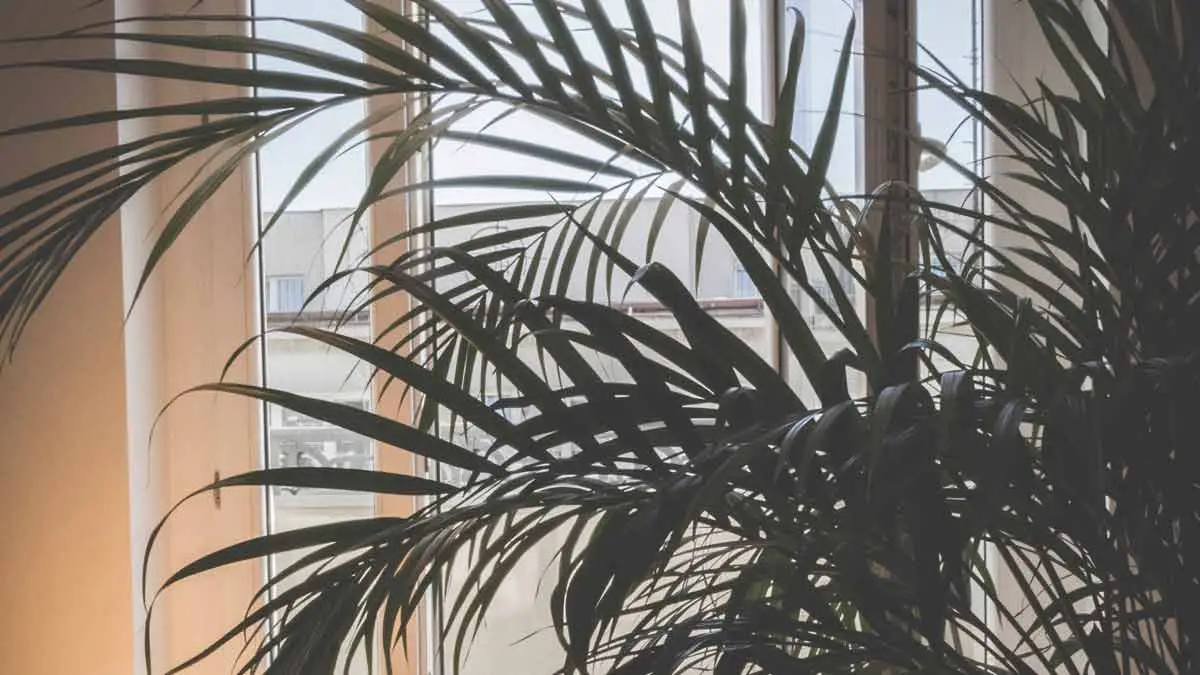Indoor palm trees may droop due to various causes, such as overwatering, underwatering, low humidity, high temperatures, inadequate light, or pests. To revive a dying palm, increase humidity, water deeply twice a week, and avoid direct sunlight. Ensure proper drainage and avoid letting the soil dry for too long.
Living with an indoor palm can be a great source of joy and beauty.
But sometimes, these majestic plants can start to droop and look sad. This is not only unsightly, but it can also indicate that something is wrong with your plant’s health.
So why is my indoor palm drooping?
In this article, we’ll discuss the common reasons why an indoor palm might be drooping and how to revive it, so it looks as vibrant and healthy as ever.
From lack of water to too much sun exposure, there are plenty of potential culprits for a droopy palm plant. Read on to discover some simple steps to fix the problem!
Causes of Indoor Palm Drooping
Indoor palms can start to droop for a variety of reasons, including:
Overwatering
One of the most common issues with indoor palms is overwatering, which can cause the leaves to droop and eventually die.
Overwatering is when too much water is given to a plant. This can happen when the soil lacks drainage or the plant is watered too frequently.
When there’s too much water in the soil, it prevents oxygen from reaching the roots of the plant, causing them to rot and die. This leads to drooping leaves and discoloration of the foliage.
Palm trees are especially susceptible to overwatering because they need well-draining soil that’s not overly saturated with water.
If your indoor palm tree leaves start to turn yellow or droop, it’s likely due to overwatering.
The best way to prevent this from happening is by watering your palm tree only when the top inch or two of soil feels dry.
You should also check for root rot by gently digging around in the soil near the base of your palm plant; if you see any brown or black roots, they may be dead due to overwatering.
Underwatering
Indoor palms are a great way to bring a bit of the outdoors into your home. But if you’re not careful, your indoor palm plant can start to droop and even die due to underwatering.
So what is underwatering, and why does it cause indoor palms to droop?
Underwatering occurs when the soil in which an indoor palm is planted is allowed to dry out for too long. This can happen when the soil isn’t watered enough or when the water drains away too quickly.
When this happens, the plant’s roots don’t get enough moisture and begin to dry out, causing them to become weak and unable to support the weight of the plant.
As a result, leaves will start to droop and may eventually fall off completely.
In addition, underwatering can also cause other issues, such as leaf yellowing, brown tips on leaves, and stunted growth.
Fortunately, there are ways you can prevent underwatering from happening in the first place.
The most important thing is to make sure that your indoor palm is getting enough water. This means checking the soil regularly and ensuring it’s damp but not soggy.
You should also consider using a moisture meter or hygrometer to ensure your palm tree gets the proper amount of water for its needs.
Low Humidity
Low humidity is a measure of the amount of water vapor in the air. It is typically measured with a hygrometer and expressed as a percentage, with 100% being the most moisture-saturated air possible. When humidity levels drop below 40%, it can cause serious plant problems.
One of the most common issues low humidity can cause is drooping leaves on indoor palms. This is because the plant’s cells cannot absorb enough water due to the lack of moisture in the air.
To solve this issue, you can increase your indoor palm’s humidity by misting its leaves with a spray bottle filled with clean water and grouping plants together to benefit from each other’s humidity.
You can also use a humidifier or place your palm plant near a bowl of water to help increase the humidity.
Another great way to improve humidity is by placing your plants on trays filled with gravel and water.
The water will evaporate, creating moist air around the plant to help it maintain its health.
As long as you keep an eye on the levels and take action when they drop, you should be able to keep your indoor palm healthy and free of drooping leaves.
High Temperatures
High temperatures can cause indoor palms to droop for several reasons.
First, the palm’s soil may become too dry due to increased evaporation caused by higher temperatures. This lack of water can lead to dehydration and wilting of the leaves.
Additionally, if the temperature is too hot for too long, it can cause stress on the plant and lead to drooping leaves.
Another reason high temperatures may cause indoor palms to droop is inadequate humidity levels in the air around them.
Palms need a certain humidity level to thrive, and if they don’t get enough moisture in the air, their leaves will start to droop as a sign of distress.
Fortunately, there are some steps you can take to help your indoor palms stay healthy despite rising temperatures:
- Make sure you regularly water your plants so their soil does not become overly dry or soggy.
- Increase humidity levels around your plants by misting them with water or using a humidifier.
- Move your plants closer to windows or other sources of natural light; and
- Consider investing in an air conditioning unit or fan for your home so that temperatures remain comfortable for your plants.
Inadequate Drainage
One of the most common issues affecting indoor palms is inadequate drainage, which can cause the leaves to droop and even lead to death.
Inadequate drainage occurs when water cannot properly drain away from the plant’s roots. This can be caused by various factors, including overwatering, poor soil quality, or incorrect pot size.
When water accumulates around the roots of an indoor palm tree, it can cause root rot and other diseases that will eventually lead to drooping leaves.
Overwatering is one of the most common causes of inadequate drainage in indoor palms.
If you’re giving your palm too much water, it won’t be able to absorb all of it, and some will remain in the soil around its roots. This excess water will prevent oxygen from reaching the roots, leading to root rot and eventual drooping leaves.
Incorrect pot size is another common issue leading to inadequate drainage in indoor palms.
If your pot is too small for your palm tree’s root system, there won’t be enough room for excess water to drain away properly.
It’s important to choose a large pot for your palm tree so that it has plenty of room for its roots and excess water can escape easily.
Finally, poor soil quality can also contribute to inadequate drainage in indoor palms.
A potting mix with too much clay or organic matter will retain moisture more than sandy soils do, making it difficult for excess water to escape from around the roots of your indoor palm tree.
To ensure proper drainage in your indoor palm tree’s soil mix, make sure you use a combination of sand and organic matter, such as peat moss or composted manure.
Inadequate drainage is a serious issue that can cause serious damage to your indoor palms if left unchecked.
Incorrect Light Exposure
Indoor palms are a great way to bring a bit of nature indoors and can be a beautiful addition to any home. However, if you’re not careful, your indoor palm tree may droop due to incorrect light exposure.
Incorrect light exposure is when the amount of light that your indoor palm receives is either too much or too little for it to thrive.
Too much light can cause the palm leaves to bleach and dry out, while too little light can cause the leaves to become limp and droop.
If you notice that your indoor palm is starting to droop, one of the first things you should check is how much light it’s receiving.
Make sure it gets enough indirect sunlight throughout the day, but not so much that it’s becoming scorched by direct sunlight.
If you find that your indoor palm is in an area with too much direct sunlight, try moving it to a spot with more indirect sunlight or providing some shade with curtains or blinds.
It’s also important to ensure that your indoor palm isn’t receiving too little light, as this can also cause drooping palm leaves.
If you find that your indoor palm isn’t getting enough natural sunlight, consider investing in some grow lights to get the right amount of light each day.
By making sure your indoor palm gets just the right amount of light each day, you can help prevent its leaves from drooping and keep it looking healthy and vibrant for years to come!
Pests
Pests such as mealybugs, scale insects, and spider mites can cause indoor palms to droop.
Mealybugs are small white bugs that suck on the sap from the leaves and stems of plants, while scale insects form hard shells over their bodies and attach themselves to the leaves and stems of plants.
Spider mites are tiny eight-legged creatures that feed on plant juices and create webs on the undersides of palm leaves.
All three types of pests can weaken a plant’s health by sucking out its nutrients, leading to drooping or wilting leaves.
If you suspect pests are causing your indoor palm tree to droop, taking action quickly is important.
Start by inspecting the plant closely for signs of pests, such as webbing or white spots on its leaves.
If you find any, use a cotton swab dipped in rubbing alcohol to remove them from the plant.
You may also want to use an insecticidal soap or neem oil spray to kill any remaining pests.
Finally, ensure your indoor palm tree gets enough water and light to recover from any damage caused by pests.
Diseases
Finally, diseases such as root rot and fungal infections can cause your indoor palm tree to droop. If left untreated, a dying palm tree can quickly become a focal point of concern in your indoor garden.
Root rot is a fungus that infects the roots of plants and prevents them from absorbing water and essential nutrients. Fungal infections are caused by spores that attach themselves to plants and spread quickly if not treated.
Yellow or brown spots on the leaves and stems of plants and drooping or wilting indicate fungal infections.
Fortunately, there are steps you can take to prevent these diseases from affecting your indoor palm trees.
Make sure you provide your plants with adequate light and water. Too much or too little of either could cause problems for your plants.
Additionally, avoid overwatering or overfertilizing your plants; both can lead to nutrient deficiencies that could cause damage over time.
Finally, inspect your plants regularly for signs of disease so you can catch any issues early on before they become serious problems.
How To Revive a Drooping Indoor Palm
Reviving a drooping indoor palm is possible if you take the right steps to address the underlying cause. To get your palm looking healthy again, here are some steps you can take:
- Identify the Root Cause – Drooping leaves on an indoor palm can be caused by various issues, from improper lighting and watering to pest infestations and nutrient deficiencies. Properly diagnosing the cause of drooping is essential for reviving your plant.
- Adjust Watering Frequency – Overwatering is a common cause of drooping leaves on indoor palms. Make sure you are not giving your palm too much water by adjusting your watering schedule and checking the soil for moisture before each watering session.
- Increase Humidity – Indoor palms often require higher humidity levels than the average home provides. Increase the humidity in your home by misting your palm regularly and placing it near a humidifier or other sources of moisture.
- Provide Proper Light – Indoor palms need bright indirect light to thrive. If you don’t have enough natural light, consider using a grow light to provide additional illumination.
- Ensure Good Drainage – Poor drainage can lead to overwatering and root rot, which can cause drooping. Ensure your indoor palm is planted in a pot with plenty of drainage holes to ensure good water flow.
- Avoid Direct Sunlight and Temperature Extremes – Too much direct sunlight or extreme temperatures can cause your indoor palm to droop. Ensure you keep your plant in a spot that’s not too hot or cold and doesn’t get direct sunlight.
- Remove Dead Leaves – Removing any dead leaves from the plant helps it conserve resources, which will help its overall health and revive drooping leaves.
- Protect the Plant From Stress – Indoor palms can be easily stressed by changes in environment or care, which can cause drooping leaves. To protect your plant from stress, avoid sudden changes and provide consistent care.
By taking these steps, you should be able to revive a drooping indoor palm and get it looking healthy again.
Final Thoughts
It can take some time and patience to revive a drooping indoor palm, but with the right care and attention, you’ll soon be able to get your plant looking healthy and vibrant.
Remember that it is important to determine why the plant is drooping in the first place before attempting any corrective action.
Pay close attention to the environment around your plant. Check its soil regularly, and adjust the light and watering schedule as needed.
Finally, protect the palm from stress by avoiding temperature extremes and using a protective cover whenever possible.
With proper care, you can keep your indoor palm looking beautiful for years to come.







